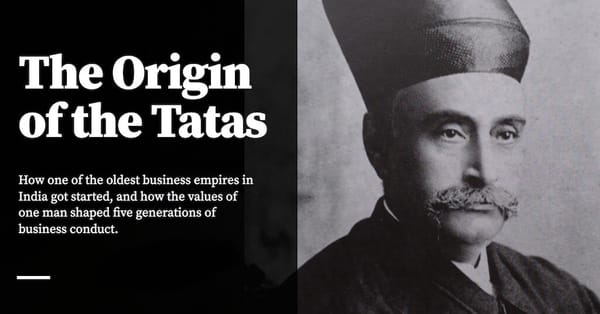Note: This is Part 10 in a series of articles and cases on Asian Conglomerates. Read Part 9 here. You may read more about the Asian Conglomerate Series here, or view all the published cases here.
Of all the Asian tycoons that I’ve studied, none are greater — or more unusual — than the Tatas. Here is a family who has been in business for five generations (or six, if you count Jamshetji’s father Nusserwanji Tata). Five generations is a long time. Jamshetji started doing business for his father, under the British; his children accomplished the three things — steel, electricity and basic science — that the early Tatas were most known for (coincidentally securing the future of their empire as they did so); J.R.D Tata expanded the group, and then Ratan Tata institutionalised the sprawling conglomerate that had sprung up during J.R.D’s time. Today, a new generation of Jamshetji’s great-great-grandchildren are rising to take up the mantle.
The Tatas are renowned for their ethical behaviour, for their loyalty to their employees, for their early focus on welfare, and for their patriotism and dedication to the cause of India. All this, in a country not known for ethical business behaviour.
There is much to say about the Tata group, and there is much that is unique about their business structure. At this point in the Asian Conglomerate series we know why corruption exists wherever weak institutions, regulation, and the pressures of competitive arbitrage exist. To my mind, the most interesting question about the Tatas is this: how did they get by with so little corruption?
The answer to this question is both an accident of history, as well as remnants of the personal values of Jamshetji Tata, born 1839, died 1904 — a British subject his entire life, and a giant of a man.
This path dependence is important. And so in order to understand the Tatas, we need to start at the beginning. It’s not too much of a stretch to say that Jamshetji’s ideals laid the foundation for the empire.
Alert readers would know to read this and compare with our earlier case on Dhirubhai Ambani, and to pattern match against the ‘core arc’ of the Asian Tycoon, outlined in How to Become an Asian Tycoon.
The Life and Times of Jamshetji Tata
Long before he became the father of Indian industry, a young Jamshetji Nusserwanji Tata spent a night in jail. He was not jailed for breaking the law, but was instead incarcerated as a matter of principle. At the Prince of Wales’s wedding celebration in British-ruled India, the British elite had drawn invisible lines between themselves and their Indian counterparts. Jamshetji was assigned a seat, along with a business partner at his father’s firm. An over-zealous English official, searching for a seat for some English ladies, seized his partner’s chair and attempted to carry it away. Jamshetji refused. They got into an argument. The official threatened him with confinement; Jamshetji was undeterred. He spent the night under arrest. Though he was granted bail the very next day, he demanded and received an apology. 30 years later, reflecting on the subtle humiliations of colonial society, he said: “If some Englishmen treated us more considerately, there would be more harmony than there is... It is in the clubs and institutions that a certain amount of antipathy is stirred up, and that is all.”
Jameshetji was 24 years old at the time. He was already a fairly accomplished trader, and married with one son. This was the sort of man he was.
Jamshetji Tata was born in 1839, to a trader by the name of Nusserwanji Tata. He grew up in Navsari, a small town in Gujarat primarily occupied by Parsis. The Parsis are a Zoroastrian community, descended from Persians who fled persecution in Persia (modern-day Iran) after the Islamic conquest in the 7th century. Navsari, in particular, was the headquarters of the priestly families of Parsis in Western India. The Tata’s also belonged to the priestly class. Despite forming a minority in India, Parsis gained a prominent position in Indian commerce. Their willingness to socialise and form connections with the British led them to become India’s wealthiest minority. Jamshetji’s contributions would also add to the Tatas becoming a part of the wealthiest minority.
Jamshetji started at the age of 18 at his father’s firm, Nusserwanji and Kaliandas. They were general merchants. The young Tata learned about various commodities and markets and within a few months, was developing the China trade. Soon after, Nusserwanji dispatched him to Hong Kong to lay the foundations of the China House. A few months later, he was off to Shanghai to open another branch.
Working for his father, he witnessed firsthand how India lagged behind its global rivals — its people exploited, its industries trailing by a century.
Long before Jamshetji’s time, before the invention of the telegraph or the advent of railways, large quantities of goods and products were exported around the world, from Europe to China. The cotton textile industry was also well-established long before Jamshetji entered the field.
Until 1863, Jamshetji spent time learning about the Eastern markets. So far, he was unexposed to the challenges of business life. At the time, the cotton trade was easy, and highly lucrative. Due to the American Civil War, cotton spinners in England sided with the cause of the North against the slave-owning Confederate South, and boycotted cotton from the Confederate states. They switched their cotton suppliers to India instead, despite the lower quality. This caused a boom in the British colony.
When Jamshetji returned, Bombay was at peak euphoria, simultaneously drifting towards a financial crisis. One of the firm’s partners, Premchand Roychand, practically gambled away the company. During the boom, the export of raw cotton rose from 835,000 bales to nearly twice that and at much higher prices. Roychand had revelled in the success, buying multiple real estate properties and making risky investments. This was the general mood of the entire industry — folks were spending money on precious metals, real estate, and other speculative ventures.
Soon, India’s imports of gold and silver rose to the point where the Asiatic Bank’s shares climbed by 65%. Bank of Baroda which had so far only advanced money on government securities, doubled its capital and altered its charter to start lending to private firms. A few months later, banks were lending on every class of security. The Bombay Chamber of Commerce warned against this, but no one batted an eye.
In 1864, Jamshetji’s father, Nusserwanji was on his way to England, carrying a few securities, including a sheaf of bills on the China market. While at sea, the first fissures of the crash appeared. The bills he carried became worthless. Frank Harris, in his book, Jamshetji Nusserwaji Tata, described it best:
“He had arrived in England bearing scrip, which he hoped would prove not only negotiable but profitable security. He found his pockets stuffed with waste paper, his credit impaired, and the good name of his firm already at stake.”
Nusserwanji instructed Roychand to sell their cotton at once. However, Roychand decided to hold on, hoping that the prices would rise. Soon after Jamshetji — sailing after his father — landed in England, the price of cotton was underground.
Roychand was ruined. Nusserwanji had to sell his house to pay off his creditors. This was Jamshetji’s first encounter with the capital cycle. He went to his creditors with clean hands, stating his position as it was. Impressed by his honesty, they appointed him as his own liquidator, with an allowance of £20 a month.
When the dust settled, Jamshetji had his mind set on an ambition he discovered in Manchester — the manufacture of cotton goods. Coincidentally, a derelict mill in Chinchpoogly, Bombay had become bankrupt. He formed a new company with an associate from England and a few friends to buy the mill. They renamed it as Alexandra Mills. Despite having no experience in the cotton manufacturing industry, Jamshetji triumphed. He managed to single-handedly make a profit in two years and eventually sold the cotton mill to Kesowji Naik, a prominent mill owner.
What differentiated him from other cotton mill owners was that the mills and his other experimental business ventures were only a means to an end, not the end itself. One underlying goal powered everything he did: bringing growth and wealth to India and its people.
With enough capital and knowledge, he went back to England to further study the Lancashire cotton trade, especially for modern machinery. His ambition took him to Egypt, Syria, Palestine, Turkey and Russia. He experienced new fruits, spices, plants and more — all of which he kept bringing back to India, never losing sight of why he was on this journey.
An elderly Jamshetji at his desk.
Jamshetji’s model mills
After six years of working as a merchant, and a short stint as a cotton mill owner, Jamshetji decided to go all in into the cotton trade. However, he was not the first Parsi to have this idea. In 1851, Mr. Cowasji Nanabhoy Davar established the first cotton mill in Bombay. A couple of decades later, 15 mills had popped up.
Despite 20 years of growth in the cotton industry, India still lacked the efficiency needed to take advantage of the ready supply of raw materials. India’s European rivals were on the opposite end of the spectrum — they had the modern machinery but not enough raw materials. In India, the machinery was old-fashioned and the buildings were not conducive to manufacturing with no ventilation or fire protection. Labour was cheap but unskilled and untrained with no welfare benefits.
India needed a champion to harness the power of easy access to raw materials combined with a robust and organised system.
A part of the problem was Bombay — or, as they called it, the ‘Cottonpolis’ of India. Manufacturers had blinders on and refused to understand that Bombay was too remote from the cotton growing districts. Jamshetji decided to find a mill in a city within reach of raw materials, where coal and water were accessible. His first pick was Jubbulpore, but when he feared riots from local religious groups, he pivoted to Nagpur. Nagpur checked all the boxes, with the added benefit of cheap land and a terminus of the Indian railway in the city.
Locking down the location was only the beginning. Locals were skilled in hand spinning and weaving but knew nothing about efficiency. When he announced that he found a backward town for his new mill — his peers in Bombay laughed. A local Nagpur banker refused to subscribe to shares of Jamshetji’s company, fearing that Jamshetji was putting gold into the ground by spending money to fill up swamps on his property. He lived to regret this and said: “Mr. Tata had not put gold into the ground, but had put in earth, and had taken out gold.”
Jamshetji had his work cut out for him. He put his experience from the Alexandra Mill to use, he supervised builders, inspected machines, tested materials and checked returns. His first essential hire was Bezonji Dadabhai Mehta, a Parsi with no experience in the cotton industry, but enough experience in efficiency and organisation. Another catalyst to Empress Mills’s success was Mr. James Brooksby, who had the requisite technical knowledge.
The mill needed machinery, but which ones? Jamshetji was tempted to save costs and went with inferior machinery which produced low quality yarn in less quantity. His shares fell to half their price. To course correct, old machinery was scrapped and more efficient machinery was procured from England. Shareholders saw the results when they received a 16% dividend in 1881.
After that, he got better at problem-solving. He was involved, personally, in each issue. He hired more experts to monitor the machines, tested their output and looked for ways to improve. Every year, he made improvements in the ring spindles and planted gins and presses for the raw materials. This did so well that within a few years, old-fashioned mules and throstles were phased out. The common denominator was his readiness to immediately try new machinery sparing no expense.
However, efficiency was still not great. Jamshetji’s real test was the labour issues. Most of the workmen were insincere and around 20% of them were absent every day. With the wedding season and workers going to their hometown for months together, Empress saw multiple breaks in the workflow. Most of the labourers would get tired and take a break for a few months doing lighter work. It reached a point where the workforce changed entirely every 18 months.
To improve working conditions, proper ventilation was provided with apparatus for humidifying air. He took every precaution against fires with automatic sprinklers and safety instructions to workers.
Jamshetji solved the attendance issue and lack of incentive by rewarding regular attendance and good work. He designated one day annually, to give away prizes like gold watches, claims, bundles of cloth or medals to good workers. In the spirit of things, the employees even dressed in holiday attire.
Not all attempts at labour welfare were successful ones. Sometimes, workers simply wanted to be left alone. When Jamshetji gave them decent quarters to stay in, men preferred to live in their huts, around relatives and friends from their caste. Eventually, this scheme had to be abandoned.
One scheme at the Empress was the first of its kind — the provident fund and gratuitous pension fund for the labourers. These funds provided for the disabled and furnished gratuities to the families of those who died before retirement. This security ensured that if they served for a long period, they would have a comfortable old age. Workers who served for 20 years were further incentivized by a bonus.
Passing down knowledge to subordinates and training them was the next hurdle on the track. An apprenticeship program ensured that the juniors were fit to carry out the work. This was no ordinary program though. They had their own quarters with a billiards and reading room. In this five-year program, they were paid a salary and learned the basics through practical work. At the end of the probation, they were given a post in the department they excelled in. A university degree got them higher positions with a higher stipend. This was so successful that within a few years, almost all heads of all branches at the Empress had been through this training.
All the trial and error began to bear fruit — dividends on the Empress rose each year with an average profit of 20% per year. This affected the entire district in Nagpur as well. The area surrounding the mill expanded to include spinning and dyeing sheds, a ginning and pressing factory, and large warehouses. The premises also included residential quarters and recreation rooms.
At this point, employment in the Empress Mills itself proved as a good social standing. The workers were so well taken care of that the company suffered a loss by providing cloth, rice, and wheat on credit and at a subsidised rate. Medical help was free and two creches took care of babies. The Empress Mills also made an annual contribution to the local schools. Jamshetji did not stop here. He began night schools that taught languages, music and dance. He even built four gymnasia to encourage a healthy lifestyle.
After five years on the factory floor, Jamshetji was ready to pass the baton to his most efficient lieutenant, Mr. Bezonji Mehta. Before he returned to his modest little office in Bombay, he brought in his cousin Mr. R.D.Tata and his son, Dorabji to manage the Empress Mills. In 1887, Jamshetji, his cousin and son incorporated a company that every child in India recognises today, Tata and Sons.
In 1895, while inaugurating a new extension of the Empress Mills, Jamshetji summed up his values (bold emphasis added):
‘‘We do not claim to be more unselfish, more generous or more philanthropic than other people. But we think we started on sound and straightforward business principles, considering the interests of the shareholders our own, and the health and welfare of the employees the sure foundation of our prosperity.”
The Empress Mills proved to be a blueprint for the Tatas and other mill owners. However, a more glaring fact is that this level of labour welfare efforts does not come from a person who only works for profits. It comes from someone who deeply cares for his country and his people. Jamshetji proved this every day.
Jamshetji’s next venture was the Svadeshi Mills. This time he had one goal in mind — to compete with British manufacturers and produce a finer yarn from Indian cotton. At the time, India mostly exported raw cotton to mills in England, and only had the ability to produce lower quality textiles. He noticed that there was no reason such superior textures could not also be produced in India.
For such an ambitious goal, he chose to repurpose a liquidated mill in Kurla, Bombay, called the Dharamsi Mill or as he jokingly called it, his ‘rotten mill’. He saw the benefit of buying a ready-made mill which could be restored to running order. However, his shareholders, friends and capitalists in Bombay shook their heads.
Determined to bring the now Svadeshi Mill to life, his first order of business was to fix his payment structure. Profit or no profit, Jamshetji had always paid a quarter anna to his agents as a commission on every pound of yarn and cloth. He realised this was a vicious system. It meant he was forced to give large sums to men who were unqualified for the work they were doing. To change this, he abolished commissions and set up a much fairer system — a commission of 10% on the actual profits earned.
The next step was to bring his experts from Nagpur, Mr. Bezonji Mehta, Mr. Brooksby and Mr. Roscoe to work their magic in Bombay. When they arrived, they found that the workers from the Dharamsi Mill, at least those who agreed to resume work, were nothing but an ill-disciplined mob. Gambling, theft, riots and strikes were a regular occurrence. Another struggle was to keep workers in Kurla. Even though the wages were higher, workers did not want to migrate to Bombay.
The mill’s infrastructure wasn’t any different. Engines and boilers were in terrible condition, and neglected machines had become useless. The machines that they managed to salvage gave the poorest results. Jamshetji soon realised that this machinery would not fetch any profits.
Jamshetji powered ahead. In 1888, the first consignment of cloth was shipped to Africa and Shanghai. They received so many complaints of the poor quality that the product proved worthless. At the end of the financial year, the Svadeshi Mill was running in losses and the share value had plummeted.
To rectify this, he was compelled to sell some of his shares in the Empress Mills. This sacrifice and Jamshetji’s passion for his work restored confidence in the shareholders.
Jamshetji was fixated on turning this around. Mr. Bezonji was brought back to suggest the right cotton required for the machinery. Mr. Roscoe, a technical expert at the Empress, was called to study every machine. New permanent staff was appointed and some were transferred from Nagpur to Kurla. The factory improvements, apprenticeship system and labour welfare schemes were also borrowed from the Empress Mills.
Finally, four years after the opening of the Svadeshi Mills, production reached a level that allowed the company to pay a dividend of Rs. 45 on each share. The Svadeshi Mills only grew from there. During the European famine of 1906, the products of Svadeshi were so well known that Tata and Sons became a guarantee of excellence even in the remote villages of Levant.
In 1894, India still under colonial rule, levied an excise duty on cotton imports. This was an underhanded move solely to benefit the British government, more specifically its cotton hub, Lancashire. Jamshetji could not accept this. He put in months of work, painstakingly surveying the mills in India based on which he prepared a report on the profits in the last 10 years. It was found that the average profits did not exceed 6%. This meant the government could not defend the import duty on the grounds that it was borne by the customer and that the average profits of the industry were normal. In any case, this did not impact Jamshetji’s profits and he eventually left the Svadeshi Mills in his son’s care.
Soon after, one of the borrowers who Jamshetji had lent to was on the verge of bankruptcy. At this time, he foreclosed and purchased the company’s mortgaged property, the Advance Mills in Ahmedabad. The name was not fooling anyone. The mill was poorly constructed and practically had no plant or machinery. He undertook yet another mill renovation. Years later the Advance Mills were valued at more than three times its cost price. Prudently, he sold it to Ahmedabad Advance Mills Ltd.
Jamshetji’s twisted business experiments
Mr. Tata had an insatiable need to solve every business problem. He was fed up with the high freight charges of steamship companies. The biggest culprit was the Peninsular and Oriental line that transported cotton goods, yarn and opium. In typical Jamshetji fashion, he declared a war on freight. His battle card was to build his own shipping company called the Tata Line. His underlying motivations are clear in the letter to his sons (bold emphasis added):
“This is not only for the good and benefit of our firm or family, but for that of our community, who have lost an old business of theirs: for our mill industry, in which we are so heavily interested, and on which the prosperity of Bombay so much depends. I am an old man now, and cannot take any active part in this business, but I will have reason to be proud if the Tata family and its young ones make a name in Bombay by efforts directed towards its prosperity and glory.”
He was definitely onto something because the Peninsular and Oriental line was forced to slam their prices so low that the Tata Line was pushed out of business.
He went on to experiment with all sorts of businesses which were too ahead of their time. Jamshetji began a mango export business which turned out to be too cost-heavy and unprofitable. Noticing a scarcity of fish during monsoon, his focus shifted to starting a cold storage business to preserve fish, fruit and meat. This did not work out and it took 20 years for Bombay to have adequate cold storage for storing meat.
To improve the water supply in his district he sunk wells which also benefited the neighbouring villages. Whenever he saw a new fruit or vegetable on his travels, he would bring back the seeds to grow them in India. His son once asked why he spent so much money on trees, he answered: “If one tree thrives and helps to feed the people, my purpose is served.”
He even brought back furniture so it could be copied and produced in India. While in Italy, he saw how silk was made and thought this would suit well for the Indian climate. He found a site in Mysore to build a silk farm, imported Japanese machinery and placed the farm under the supervision of two Japanese experts who taught reeling to the workers. This was so successful that India’s Department of Agriculture consulted him when they were establishing farms on a similar basis.
A less successful venture was to bring Egyptian cotton to India. This finer cotton was needed to meet the growing competition. While the government made efforts to encourage cotton growing, the public did not care for it. Jamshetji even offered to bear the burden of any loss. In the end, India’s weather conditions did not support growing such cotton.
Jamshetji’s recipe for India’s prosperity
Jamshetji had amassed enough wealth to retire early but his work was not done. At the end of his life, he concluded that India needed three ingredients to exceed its rivals: steel, electric power and technical education combined with research.
While he did not live to see the completion of any of these, his sons and successors achieved all three not long after his death. They set up the iron and steel plants at Jamshedpur, built hydro-electric schemes that made Bombay independent from using coal and established the Indian Institute of Science in Bangalore providing world-class post-graduate education. How they accomplished this is a story for another case.
Jamshetji Tata didn’t just build mills, he built the foundation for modern Indian industry. His relentless pursuit of efficiency, innovation, and worker welfare wasn’t just good business; it was nation-building. A century later, the industries he ignited and the principles he championed still power India’s economic engine.
Wrapping Up
The goal of this instalment was to introduce you to the founder of the Tata empire. We’ll talk about the rest of the Tatas in a future instalment.
Jamshetji Tata was an unusual man. Most biographies of Jamshetji tell the story of his life as such: that he learnt the cotton trade, got rich early, lost most of it as a young man, rebuilt and outdid his competitors, travelled widely and experienced many cultures and met many men, and then, finally, died; that the arc of his life and his wealth was a setup for the three things — steel, electricity, and science — that became his legacy. Jamshetji’s lack of success in many of the businesses he started later in his life is perhaps an indication that he lacked a proper understanding of business dynamics, or that he was driven by things other than profit. Fortunately, of the three things he left behind as his gift to the as-yet unborn nation of India; one of them — steel — became the engine that secured the fortunes of his heirs.
I’ve read a lot of tycoon history. Jamshetji’s life is one of those rare stories where idealism happened to be precisely the right decision for the future prosperity of his business empire. Perhaps he was blessed by the fortunes.
But we’ll see how that happens in the near future.
This is Part 10 of The Asian Conglomerate Series. You can read Part 11 here: The Art of the Asian Joint Venture.
Originally published , last updated .
This article is part of the Operations topic cluster, which belongs to the Business Expertise Triad. Read more from this topic here→
This article is part of the Market topic cluster, which belongs to the Business Expertise Triad. Read more from this topic here→






